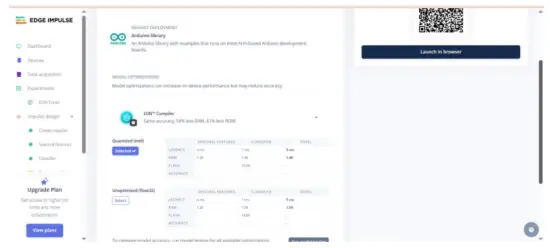

ABX00087 UNO R4 WiFi Development Board
Cricket Shot Recognition pogwiritsa ntchito Arduino UNO R4 WiFi + ADXL345 + Edge
Chisonkhezero
Chikalatachi chimapereka mayendedwe athunthu pomanga makina ozindikira kuwombera kwa cricket pogwiritsa ntchito Arduino UNO R4 WiFi yokhala ndi ADXL345 accelerometer ndi Edge Impulse Studio. Ntchitoyi imaphatikizapo kusonkhanitsa deta ya accelerometer, kuphunzitsa chitsanzo cha makina ophunzirira, ndi kutumiza chitsanzo chophunzitsidwa kubwerera ku Arduino kuti chikhale chowombera nthawi yeniyeni.
Masewera a Cricket omwe amaganiziridwa mu polojekitiyi:
- Kuyendetsa galimoto
- Kuyendetsa molunjika
- Kokani Kuwombera
Gawo 1: Zofunikira pa Hardware
- Arduino UNO R4 WiFi
- ADXL345 Accelerometer (I2C)
- Mawaya a Jumper
- Breadboard (ngati mukufuna)
- Chingwe cha USB Type-C
Gawo 2: Zofunikira pa Mapulogalamu
- Arduino IDE (posachedwa)
- Akaunti ya Edge Impulse Studio (yaulere)
- Zida za Edge Impulse CLI (Node.js ikufunika)
- laibulale ya Adafruit ADXL345
Khwerero 3: Wiring the ADXL345
Lumikizani sensor ya ADXL345 ku Arduino UNO R4 WiFi motere:
VCC → 3.3V
GND → GND
SDA → SDA (A4)
SCL → SCL (A5)
CS → 3.3V (ngati mukufuna, ya I2C mode)
SDO → yoyandama kapena GND
Khwerero 4: Pangani Sensor ya IDE Yokonzeka
Momwe Mungayikitsire Sensor Library mu Arduino IDE?
Tsegulani Arduino IDE
Tsegulani Zida → Sinthani malaibulale… ndikuyika: Adafruit ADXL345 Unified Adafruit Unified Sensor
(Ngati muli ndi LSM6DSO kapena MPU6050 m'malo mwake: ikani SparkFun LSM6DSO , Adafruit LSM6DS kapena MPU6050 moyenerera.)
Khwerero 5: Sketch ya Arduino Yosonkhanitsa Data
Kwezani chojambulachi ku Arduino UNO R4 WiFi yanu. Imayendetsa data ya accelerometer mumtundu wa CSV (x,y,z) pa ~ 18 Hz ya Edge Impulse.
#kuphatikizapo
#kuphatikizapo
Adafruit_ADXL345_Unified accel =
Adafruit_ADXL345_Unified(12345);
kukhazikitsa opanda kanthu () {
Seri.begin(115200);
ngati (!accel.begin()) {
Serial.println(“Palibe ADXL345 wapezeka”);
pamene (1);
}
accel.setRange(ADXL345_RANGE_4_G);
}
lopu yopanda kanthu () {
masensa_zochitika_t e;
accel.getEvent(&e);
Seri.print (e.acceleration.x);
Serial.print(",");
Seri.print(e.acceleration.y);
Serial.print(",");
Seri.println(e.acceleration.z);kuchedwa(55); // ~ 18 Hz
}
Khazikitsani Edge Impulse

Khwerero 6: Lumikizani ku Edge Impulse
- Tsekani Arduino seri Monitor.
- Thamangani lamulo: m'mphepete-impulse-data-forwarder -frequency 18
- Lowetsani mayina a axis: accX, accY, accZ
- Tchulani chipangizo chanu: Arduino-Cricket-Board
- Tsimikizirani kugwirizana mu Edge Impulse Studio pansi pa 'Devices'.


Gawo 7: Kusonkhanitsa Zambiri
Mu Edge Impulse Studio → Kupeza deta:
- Chipangizo: Arduino-Cricket-Board
- Sensor: Accelerometer (3 nkhwangwa)
-Sampkutalika: 2000 ms (2 masekondi)
- pafupipafupi: 18 Hz
Lembani zosachepera 40 sampzochepa pa kalasi iliyonse:
- Kuyendetsa galimoto
- Kuyendetsa molunjika
- Kokani Kuwombera Sungani Data Examples
Sungani Data Examples
Kuphimba Drive
Chipangizo: Arduino-Cricket-Board
Chizindikiro: Cover Drive
Sensor: Sensor yokhala ndi nkhwangwa zitatu (accX, accY, accZ)
Sampkutalika: 10000ms
pafupipafupi: 18 Hz
Exampndi Raw Data:
accX -0.32
Mtengo wa 9.61
accZ -0.12
Kuyendetsa Molunjika
Chipangizo: Arduino-Cricket-Board
Chizindikiro: Kuyendetsa Molunjika
Sensor: Sensor yokhala ndi nkhwangwa zitatu (accX, accY, accZ)
Sampkutalika: 10000ms
pafupipafupi: 18 Hz
Exampndi Raw Data:
accX 1.24
Mtengo wa 8.93
accZ -0.42
Kokani Kuwombera
Chipangizo: Arduino-Cricket-Board
Label: Koka Kuwombera
Sensor: Sensor yokhala ndi nkhwangwa zitatu (accX, accY, accZ)
Sampkutalika: 10000 ms
pafupipafupi: 18 Hz
Exampndi Raw Data:
accX 2.01
Mtengo wa 7.84
accZ -0.63 
Khwerero 8: Mapangidwe a Impulse
Tsegulani Pangani chikhumbo:
Cholowera: Zambiri zanthawi (ma ax 3).
Kukula kwazenera: 1000 ms Kuwonjezeka kwazenera (kuyambira): 200 ms Yambitsani: Nkhwangwa, Kukula (posankha), pafupipafupi 18.
Chotchinga: Kusanthula kwa Spectral (aka Spectral Features for motion). Kukula kwazenera: 1000 ms Kuwonjezeka kwazenera (kuyambira): 200 ms Yambitsani: Nkhwangwa, Kukula (posankha), sungani zosintha zonse poyamba.
Gulu lophunzirira: Gulu (Keras).
Dinani Sungani zomwe mukufuna. 
Pangani mawonekedwe:
Pitani ku Kusanthula kwa Spectral, dinani Sungani magawo, kenako Pangani zida zophunzitsira.

Phunzitsani chitsanzo chaching'ono
Pitani ku Classifier (Keras) ndikugwiritsa ntchito compact config monga:
Neural network: 1-2 wandiweyani zigawo (mwachitsanzo, 60 → 30), ReLU
Nthawi: 40-60
Chiwerengero cha maphunziro: 0.001-0.005
Kukula kwa gulu: 32
Kugawa kwa data: 80/20 (sitima / mayeso)
Sungani ndi kuphunzitsa deta
Yang'anani ndikuyang'ana kuyezetsa kwa Model ndi chosungira.
Onani chisokonezo masanjidwewo; ngati bwalo ndi mmwamba zikulumikizana, sonkhanitsani zambiri zosiyanasiyana kapena kusintha
Ma parameter a Spectral (kukula kwazenera / phokoso pansi).
Khwerero 9: Kutumiza ku Arduino
Pitani ku Deployment:
Sankhani laibulale ya Arduino (laibulale ya C ++ imagwiranso ntchito).
Yambitsani EON Compiler (ngati ilipo) kuti muchepetse kukula kwachitsanzo.  Tsitsani .zip, kenako Arduino IDE: Sketch → Phatikizani Library → Add .ZIP Library… Izi zikuwonjezera exampmonga Static buffer ndi Continuous under File → Eksampizi →
Tsitsani .zip, kenako Arduino IDE: Sketch → Phatikizani Library → Add .ZIP Library… Izi zikuwonjezera exampmonga Static buffer ndi Continuous under File → Eksampizi →
Dzina Lanu Ntchito - Edge Impulse. Chojambula cha Arduino UNO EK R4 WiFi + ADXL345.
Khwerero 10: Sketch Inference ya Arduino
#kuphatikizapo
#kuphatikizapo
#kuphatikizapo // Bwezerani ndi mutu wa Edge Impulse
Adafruit_ADXL345_Unified accel =
Adafruit_ADXL345_Unified(12345);
static boool debug_nn = zabodza;
kukhazikitsa opanda kanthu () {
Seri.begin(115200);
pomwe (!Seriyo) {}
ngati (!accel.begin()) {
Serial.println(“ZOPHUNZITSA: ADXL345 sizinazindikirike”);
pamene (1);
}
accel.setRange(ADXL345_RANGE_4_G);
}
lopu yopanda kanthu () {
chotchinga choyandama[EI_CLASSIFIER_DSP_INPUT_FRAME_SIZE] = {0};
kwa (size_t ix = 0; ix <EI_CLASSIFIER_DSP_INPUT_FRAME_SIZE; ix +=
3) {
uint64_t next_tick = micros() + (EI_CLASSIFIER_INTERVAL_MS *
1000);
masensa_zochitika_t e;
accel.getEvent(&e);
buffer[ix + 0] = e.acceleration.x;
buffer[ix + 1] = e.acceleration.y;
buffer[ix + 2] = e.acceleration.z;
int32_t wait = (int32_t)(next_tick – micros());
ngati (dikirani> 0) kuchedwaMicroseconds(dikirani);
}
chizindikiro_t chizindikiro;
int err = numpy::signal_from_buffer(buffer,
EI_CLASSIFIER_DSP_INPUT_FRAME_SIZE, &signal);
ngati (kulakwitsa!= 0) kubwerera;
ei_impulse_result_t zotsatira = {0};
EI_IMPULSE_ERROR res = run_classifier(&signal, &result,
debug_nn);
ngati (res != EI_IMPULSE_OK) kubwerera;
kwa (size_t ix = 0; ix <EI_CLASSIFIER_LABEL_COUNT; ix++) {
ei_printf(“%s: %.3f “, result.classification[ix].label,
zotsatira.gulu[ix].mtengo);
}
#ngati EI_CLASSIFIER_HAS_ANOMALY == 1
ei_printf(“anomaly: %.3f”, result.anomaly);
#ndif
ei_printf(“\n”);
}
Zotulutsa exampLe:
 Malangizo:
Malangizo:
Sungani EI_CLASSIFIER_INTERVAL_MS mogwirizana ndi ma frequency anu otumizira data (monga 100 Hz → 10 ms). Laibulale ya Edge Impulse imayika izi mosalekeza kuchokera pamalingaliro anu.
Ngati mukufuna kudziwa mosalekeza (zenera lotsetsereka), yambani kuchokera ku Continuous exampndikuphatikizidwa ndi laibulale ya EI ndikusinthana ndi zowerengera za ADXL345.
Tikhala tikuwonjezera maphunziro a kanema posachedwa; mpaka pamenepo, khalani maso - https://www.youtube.com/@RobuInlabs
Ndipo ngati mukukayikabe, mutha kuwona vidiyoyi ndi Edged Impulse: https://www.youtube.com/watch?v=FseGCn-oBA0&t=468s

Zolemba / Zothandizira
 |
Arduino ABX00087 UNO R4 WiFi Development Board [pdf] Buku Logwiritsa Ntchito R4 WiFi, ADXL345, ABX00087 UNO R4 WiFi Development Board, ABX00087, UNO R4 WiFi Development Board, WiFi Development Board, Development Board, Board |